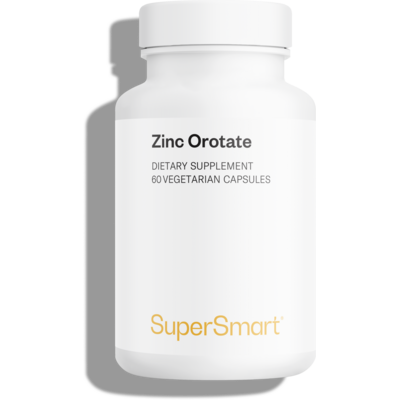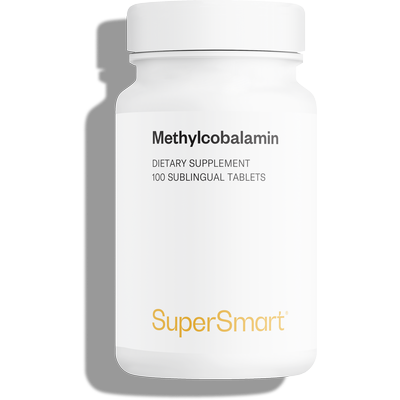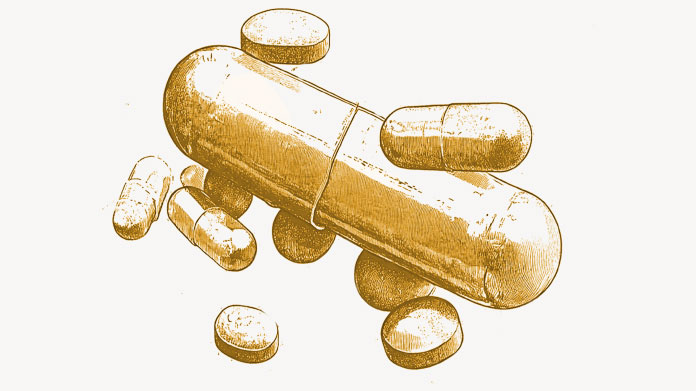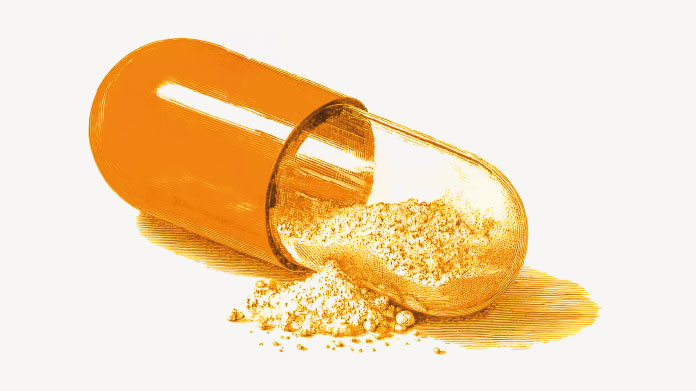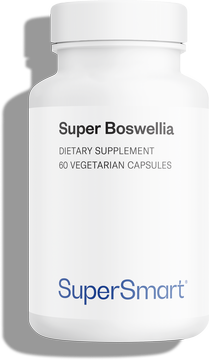Dietary supplements: which forms are the most bioavailable?
For effective supplementation, it is important to choose food supplements according to their bioavailability. Vitamins, minerals, probiotics... What are their most bioavailable forms?

Bioavailability of a substance: what are we talking about?
The term "bioavailability" is used in pharmacology to designate the proportion of a substance that reaches the bloodstream while retaining its initial form (i.e. without being broken down by digestive enzymes or intestinal bacteria, for example) (1).
This concept is important in that it determines the quantity of active ingredients likely to be effectively distributed and delivered to the target organs.
Various factors affect the bioavailability of a substance. A distinction is made between those relating to the formulation of the drug or supplement (nature of the molecules, synergistic combination, galenic form, route of administration, etc.) and those which depend on the subject being treated or supplemented (digestive absorption capacity, impairment or otherwise of liver function, time of intake, interaction with other nutrients, etc.) (2).
It is therefore implicitly understood that the bioavailability of a substance determines its effectiveness in the body.
So when you want to see real health benefits, it makes more sense to opt for 'advanced' supplements, which generally use more bioavailable forms, than for 'standard' supplements, which are cheaper but ultimately less useful.
Food supplements: which are the most bioavailable forms?
Minerals
Minerals in their traditional form (oxide, sulphate, etc.) are less well absorbed from the intestine, mainly because they are less soluble in water, but also because they compete with other substances on intestinal transporters.
As a result, they are poorly bioavailable. Chelated forms compensate for these shortcomings by using amino acids or organic compounds to escort the minerals (3).
This category includes the 'picolinate' form, which binds the mineral to picolinic acid, the 'citrate' form to citric acid, and the 'bisglycinate' form to two glycine molecules (the latter are used in zinc supplements Advanced Bisglycinate Zinc Lozenges and iron supplements Iron Bisglycinate) (4).
Fat-soluble vitamins
Fat-soluble vitamins (A, D, E and K) are unique in that they are miscible in fats.
When coupled with lipids, they are better absorbed from the intestine.
Emulsified or, better still, liposomal forms are preferable: encapsulated in fatty vesicles, they are also better protected against gastric acidity and oxidation (to which vitamins A and E are particularly sensitive) (5).
Vitamin B12
When it comes to vitamin B12 supplements, there are two main forms: cyanocobalamin and methylcobalamin.
While cyanocobalamin appears to be more stable and better absorbed, several studies suggest that methylcobalamin has a higher retention rate: in other words, it is eliminated in smaller quantities by the body (6).
It should also be noted that this active form of vitamin B12 is identical to that provided naturally by foods of animal origin (see Methylcobalamin).
Vitamin C
Compared with ordinary forms, liposomal vitamin C has superior bioavailability, as the liposomes protect it from digestive breakdown and facilitate intestinal absorption (7).
Their phospholipid structure mimics cell membranes, making it easier for them to pass through intestinal and cell walls.
This encapsulation also limits renal excretion, ensuring prolonged distribution and better retention in the body (Liposomal Vitamin C is based on a patented vitamin C similar to that found in plants).
Omega-3
Compared with synthetic ethyl esters, omega-3s in phospholipid form are better absorbed (8).
Phospholipids are the only 'vehicles' capable of transporting EPA and DHA fatty acids to the heart of cells.
Krill oil is one of the rare natural sources to combine both omega-3 and phospholipids (it is featured in Krill Oil, a supplement guaranteed to be free from heavy metals) (9).
Coenzyme Q10
Once in the body, CoQ10, or ubiquinone, is transformed into ubiquinol, its active form.
However, intestinal absorption of CoQ10 is incomplete, as is its conversion into ubiquinol (estimated at 'only' 90%).
So we might as well opt for a direct intake of ubiquinol to avoid costly intermediate stages in terms of bioavailability and make the most of this compound, which has been extensively studied in the anti-ageing field (for example, by taking Ubiquinol™) (10).
Curcumin
Considered the most biologically active compound in turmeric, curcumin is naturally poorly absorbable: relatively unstable, it dissolves with difficulty in digestive fluids and struggles to cross the intestinal wall (11).
As a result, food supplement manufacturers have devised a number of compensatory strategies to optimise its absorption: combining it with piperine from pepper (a method that has been criticised, however, because piperine increases intestinal permeability), using liposomes once again, or 'micronising' it into microscopic beads that mix easily with water (this revolutionary technique is used in Curcumin Solution, which multiplies its absorption capacity by 185) (12-13).
Probiotics
Probiotics are extremely fragile living micro-organisms.
Sensitive to heat, humidity, oxygen and above all gastric acidity, they are often destroyed or inactivated after passing through the stomach, which considerably reduces their effectiveness.
This is why, for many strains, preference should be given to microencapsulated strains which, isolated from acidic environments, arrive intact in the intestinal tract (this is the case with Probio Forte, a multi-strain probiotic packaged in gastro-resistant capsules) (14).
Collagen
The most abundant protein in the human body, collagen comes in different types (I, II, III, IV...) depending on the target tissues.
When looking to supplement, it is important to pay particular attention to molecular weight: the higher the molecular weight, the larger the molecules, the less easily they pass through intestinal and cell walls.
For this reason, hydrolysed collagen should be preferred, i.e. split into smaller peptides, which are much better assimilated (our two marine collagen supplements, Marine Collagen and Premium Collagen Shots, use this technique) (15).
However, some collagens are deliberately not hydrolysed in order to act on the immune system and reduce joint inflammation (such as UC-II®).
Berberine
Derived from barberry, berberine helps regulate blood sugar levels and maintain normal cholesterol levels.
Alongside standard berberine, there are now cutting-edge supplements which have managed to increase its bioavailability tenfold (as in the case of Berberine Max Bioactivity, which uses a new-generation delivery system combining a raw extract of Indian barberry with a pea protein carrier and grape seed extract) (16).
How can we optimise the absorption of dietary supplements?
As well as selecting the most bioavailable forms, you can also improve the absorption of your food supplements by adopting certain good practices:
- take your supplements at the right time. Fat-soluble vitamins A, D, E and K are much better absorbed with a meal containing fat, while vitamins B and C should be taken on an empty stomach with a large glass of water (17-18). As for probiotics, it is generally advisable to take them 30 minutes before eating, with a cold drink (heat is likely to destroy lactic acid bacteria) (19);
- limit interference between supplements. We know, for example, that some minerals use the same intestinal transporters for their absorption, which creates a kind of mutual competition that reduces their bioavailability. This is particularly true of calcium and iron, for which it is advisable to take them at least 2 hours apart (20);
- Avoid absorption inhibitors. Tea, which is rich in tannins, blocks the absorption of iron and calcium, so ideally you should wait an hour after taking supplements before drinking a cup (21). More generally, alcohol and tobacco reduce the assimilation of many minerals and vitamins;
combine your supplements with synergistic nutrients. Conversely, some substances are better assimilated when taken together. For example, vitamin D facilitates the absorption of calcium, and vitamin C that of iron (22-23).
SUPERSMART ADVICE
References
- Price G, Patel DA. Drug Bioavailability. [Updated 2023 Jul 30]. In: StatPearls [Internet]. Treasure Island (FL): StatPearls Publishing; 2025 Jan-. Available from: https://www.ncbi.nlm.nih.gov/books/NBK557852/
- Stielow M, Witczyńska A, Kubryń N, Fijałkowski Ł, Nowaczyk J, Nowaczyk A. The Bioavailability of Drugs-The Current State of Knowledge. 2023 Dec 11;28(24):8038. doi: 10.3390/molecules28248038. PMID: 38138529; PMCID: PMC10745386.
- Jarosz Ł, Marek A, Grądzki Z, Kwiecień M, Kalinowski M. The effect of feed supplementation with zinc chelate and zinc sulphate on selected humoral and cell-mediated immune parameters and cytokine concentration in broiler chickens. Res Vet Sci. 2017 Jun;112:59-65. doi: 10.1016/j.rvsc.2016.09.007. Epub 2016 Sep 14. PMID: 28126602.
- Gandia P, Bour D, Maurette JM, Donazzolo Y, Duchène P, Béjot M, Houin G. A bioavailability study comparing two oral formulations containing zinc (Zn bis-glycinate vs. Zn gluconate) after a single administration to twelve healthy female volunteers. Int J Vitam Nutr Res. 2007 Jul;77(4):243-8. doi: 10.1024/0300-9831.77.4.243. PMID: 18271278.
- Dałek P, Drabik D, Wołczańska H, Foryś A, Jagas M, Jędruchniewicz N, Przybyło M, Witkiewicz W, Langner M. Bioavailability by design - Vitamin D3 liposomal delivery vehicles. 2022 Jul;43:102552. doi: 10.1016/j.nano.2022.102552. Epub 2022 Mar 26. PMID: 35346834; PMCID: PMC8957331.
- Paul C, Brady DM. Comparative Bioavailability and Utilization of Particular Forms of B12 Supplements With Potential to Mitigate B12-related Genetic Polymorphisms. Integr Med (Encinitas). 2017 Feb;16(1):42-49. PMID: 28223907; PMCID: PMC5312744.
- Gopi S, Balakrishnan P. Evaluation and clinical comparison studies on liposomal and non-liposomal ascorbic acid (vitamin C) and their enhanced bioavailability. J Liposome Res. 2021 Dec;31(4):356-364. doi: 10.1080/08982104.2020.1820521. Epub 2020 Oct 6. PMID: 32901526.
- Dyerberg J, Madsen P, Møller JM, Aardestrup I, Schmidt EB. Bioavailability of marine n-3 fatty acid formulations. Prostaglandins Leukot Essent Fatty Acids. 2010 Sep;83(3):137-41. doi: 10.1016/j.plefa.2010.06.007. PMID: 20638827.
- Burri L, Hoem N, Banni S, Berge K. Marine omega-3 phospholipids: metabolism and biological activities. Int J Mol Sci. 2012 Nov 21;13(11):15401-19. doi: 10.3390/ijms131115401. PMID: 23203133; PMCID: PMC3509649.
- Zhang Y , Liu J , Chen XQ , Oliver Chen CY . Ubiquinol is superior to ubiquinone to enhance Coenzyme Q10 status in older men. Food Funct. 2018 Nov 14;9(11):5653-5659. doi: 10.1039/c8fo00971f. PMID: 30302465.
- Tabanelli R, Brogi S, Calderone V. Improving Curcumin Bioavailability: Current Strategies and Future Perspectives. 2021 Oct 17;13(10):1715. doi: 10.3390/pharmaceutics13101715. PMID: 34684008; PMCID: PMC8540263.
- Khajuria A, Thusu N, Zutshi U. Piperine modulates permeability characteristics of intestine by inducing alterations in membrane dynamics: influence on brush border membrane fluidity, ultrastructure and enzyme kinetics. 2002 Apr;9(3):224-31. doi: 10.1078/0944-7113-00114. PMID: 12046863.
- Schiborr C, Kocher A, Behnam D, Jandasek J, Toelstede S, Frank J. The oral bioavailability of curcumin from micronized powder and liquid micelles is significantly increased in healthy humans and differs between sexes. Mol Nutr Food Res. 2014 Mar;58(3):516-27. doi: 10.1002/mnfr.201300724. Epub 2014 Jan 9. Erratum in: Mol Nutr Food Res. 2014 Mar;58(3):647. Dosage error in article text. PMID: 24402825.
- Sbehat M, Mauriello G, Altamimi M. Microencapsulation of Probiotics for Food Functionalization: An Update on Literature Reviews. 2022 Sep 30;10(10):1948. doi: 10.3390/microorganisms10101948. PMID: 36296223; PMCID: PMC9610121.
- León-López A, Morales-Peñaloza A, Martínez-Juárez VM, Vargas-Torres A, Zeugolis DI, Aguirre-Álvarez G. Hydrolyzed Collagen-Sources and Applications. Molecules. 2019 Nov 7;24(22):4031. doi: 10.3390/molecules24224031. PMID: 31703345; PMCID: PMC6891674.
- Petrangolini G, Corti F, Ronchi M, Arnoldi L, Allegrini P, Riva A. Development of an Innovative Berberine Food-Grade Formulation with an Ameliorated Absorption: In Vitro Evidence Confirmed by Healthy Human Volunteers Pharmacokinetic Study. Evid Based Complement Alternat Med. 2021 Nov 27;2021:7563889. doi: 10.1155/2021/7563889. PMID: 34904017; PMCID: PMC8665891.
- Ofoedu CE, Iwouno JO, Ofoedu EO, Ogueke CC, Igwe VS, Agunwah IM, Ofoedum AF, Chacha JS, Muobike OP, Agunbiade AO, Njoku NE, Nwakaudu AA, Odimegwu NE, Ndukauba OE, Ogbonna CU, Naibaho J, Korus M, Okpala COR. Revisiting food-sourced vitamins for consumer diet and health needs: a perspective review, from vitamin classification, metabolic functions, absorption, utilization, to balancing nutritional requirements. 2021 Sep 1;9:e11940. doi: 10.7717/peerj.11940. PMID: 34557342; PMCID: PMC8418216.
- Carmel R. How I treat cobalamin (vitamin B12) deficiency. Blood. 2008 Sep 15;112(6):2214-21. doi: 10.1182/blood-2008-03-040253. Epub 2008 Jul 7. PMID: 18606874; PMCID: PMC2532799.
- Fijan S, Frauwallner A, Varga L, Langerholc T, Rogelj I, Lorber M, Lewis P, Povalej Bržan P. Health Professionals' Knowledge of Probiotics: An International Survey. Int J Environ Res Public Health. 2019 Aug 28;16(17):3128. doi: 10.3390/ijerph16173128. PMID: 31466273; PMCID: PMC6747149.
- Cook JD, Dassenko SA, Whittaker P. Calcium supplementation: effect on iron absorption. Am J Clin Nutr. 1991 Jan;53(1):106-11. doi: 10.1093/ajcn/53.1.106. PMID: 1984334.
- Zijp IM, Korver O, Tijburg LB. Effect of tea and other dietary factors on iron absorption. Crit Rev Food Sci Nutr. 2000 Sep;40(5):371-98. doi: 10.1080/10408690091189194. PMID: 11029010.
- Christakos S, Dhawan P, Porta A, Mady LJ, Seth T. Vitamin D and intestinal calcium absorption. Mol Cell Endocrinol. 2011 Dec 5;347(1-2):25-9. doi: 10.1016/j.mce.2011.05.038. Epub 2011 Jun 1. PMID: 21664413; PMCID: PMC3405161.
- Lynch SR, Cook JD. Interaction of vitamin C and iron. Ann N Y Acad Sci. 1980;355:32-44. doi: 10.1111/j.1749-6632.1980.tb21325.x. PMID: 6940487.
Keywords
3 Days
A Product worth waiting for when not…
A Product worth waiting for when not available and then arriving as a surprise!
DOMINIC
4 Days
On time shipping
On time shipping
GEORGE Verne
6 Days
Ordering was easy and the product was…
Ordering was easy and the product was delivered with no problems. Appreciated that I was notified when it would arrive. Thanks!
MascarC
12 Days
Great customer service - responsive …
I ordered from them and my item was unavailable for sometime. I was super happy when they reactivated my order and shipped my item which arrived very quickly. Great customer service.
Ruth Rueter
13 Days
Super fast shipping
Super fast shipping
Donald Borling
16 Days
Reputable companysearch and the number of…
The research and the number of selection of products.
NAKHJAVAN Shervin
29 Days
The Anti Aromatase is a great product
The Anti Aromatase is a great product. You just need to have constant inventory. Recently this product has been out of stock.
GEORGE Verne
30 Days
Great help on chat
Great help on chat. Knowledgeable and friendly.
Jason Argos
34 Days
Customer service was fast and friendly.
Customer service helped to stop the transaction process of the subscription. I appreciated that.
Greenie
34 Days
I order here due to the high quality of…
I order here due to the high quality of the products and the quick delivery of items - thank you
Barbara J
36 Days
SuperSmart's Eye Pressure supplements: highly recommended!
I purchase SuperSmart's Eye Pressure supplements regularly for over 5 years, and gotta say they are truly a wonderful product for my Glaucoma. Highly recommended if you have eye pain from your Glaucoma.
D. Martinez
40 Days
Quick service
Quick service
MONELL
41 Days
Speedy service.
Speedy service.
ROSENTHAL Marvin
45 Days
Clear website- Efficient
Clear website. Excellent search engine and fast delivery!
Mohamad Hussein
47 Days
They have great products.
They have great products.
Vickie


